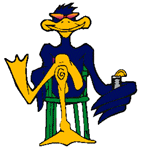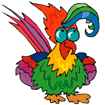-
- Promoting
Effective Communications
-
- Students and teachers now have spent
much time developing skills in using
technology tools, however an equal amount
of time needs to be spent in promoting
effective communications using these
tools. In many cases, students are simply
copying information from one source to
another rather than analyzing and
synthesizing information. In addition,
without skills in layout and design,
student communications can be lost in
unreadable fonts and distracting colors.
This design focus needs to include text,
original drawings, scanners, digital
cameras, video cameras and videos, audio
tools and clips, navigation, credits, and
other areas of project development.
|
|
-

- Cactus
Menu
- Task
- Activities
- Tools
- Resources
- Communications
- Implementation
- Evaluation
- Sharing
- Return
to Eduscapes
|
- Communication Design
- The design of effective communications depends on
both text and visual literacy.
-
- Text. Students need to shift from an
emphasis on data and information to building knowledge
and wisdom. This change in thinking is dependent on
both teaching and learning. If the assignment doesn't
ask for high level thinking, students are unlikely to
show creativity. In addition to the content of the
text, students need to learn the effective expression
both in words, but also in fonts, font size, color,
and other visual aspects. Also encourage students to
interact with readers including asking questions and
stimulating thinking.
-
- Original Drawing. Like writing, some
students have more skill than others. Start with
projects that require few skills. For example, line
drawing are easier than paintings. Or, use a specialty
software package to help students product charts and
graphs. Rather than focusing on the visual itself,
consider the message of the visual and the best tool
for conveying that message.
-
- Scanned Images. We tend to focus on
scanning paper and photographs, however remember that
other things can be scanned including fabric, book and
CD covers, natural objects, historical artifacts, and
even body parts. Again, emphasis the message of the
visual rather than the activity of using the scanner.
What purpose will the image serve?
-
- Digital Camera Pictures. A digital camera
can do many of the same things as a scanner.
Portability is the major advantage. Consider
photographing people, objects, processes, and even
emotions. For example a blown tire may convey an
emotion. Look for action and movement that can be
captured in a still picture. For instance the
toy
project shows step by step instructions to
creating a toy.
-
- Audio & Video Recordings. There are
many opportunities to integrate audio and video
recordings into projects. As you design an assignment,
ask yourself: is it relevant and high quality? Does it
contribute to an understanding of the message?
Consider all the ways that students can communicate
including sound and visual effects. Students could
read orally, conduct a skit, demonstrate an activity,
or narrate a process.
-
- Navigation. In nonlinear projects, the
design of navigation is critical. Consider a table of
contents, visual maps, and indexes at can help users
become oriented. Tools such as buttons, arrows, and
menus help a student move within the project.
-
- Interactivity. Get your audience involved
in your project. This interaction might include
practicing a skills, gaining additional information,
making a decision, or exploring an idea.
-
- Other Elements. In addition to the elements
above, many projects contain specialty design
elements. For example, all project to provide an area
for credits, references, and information about the
authors.
-
 - Cactus
Exploration
|
-
- What skills do your
students need to successfully design
effective communications? Do your students
currently have these skills? How can these
be embedded in your activities?
|
-
Cactus Menu / Task
/ Activities / Tools
/ Resources / Communications
/ Implementation / Evaluation
/ Sharing
- Return to
Eduscapes
Created by Annette
Lamb, 02/01.
|